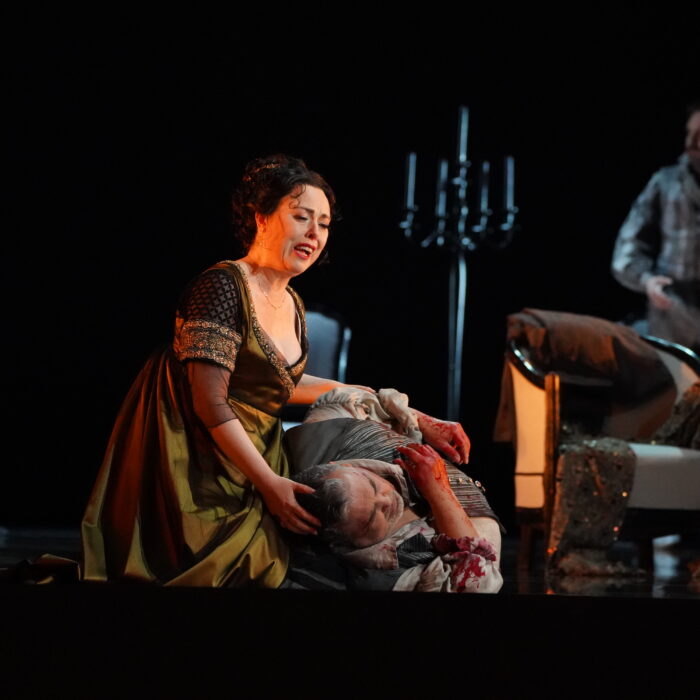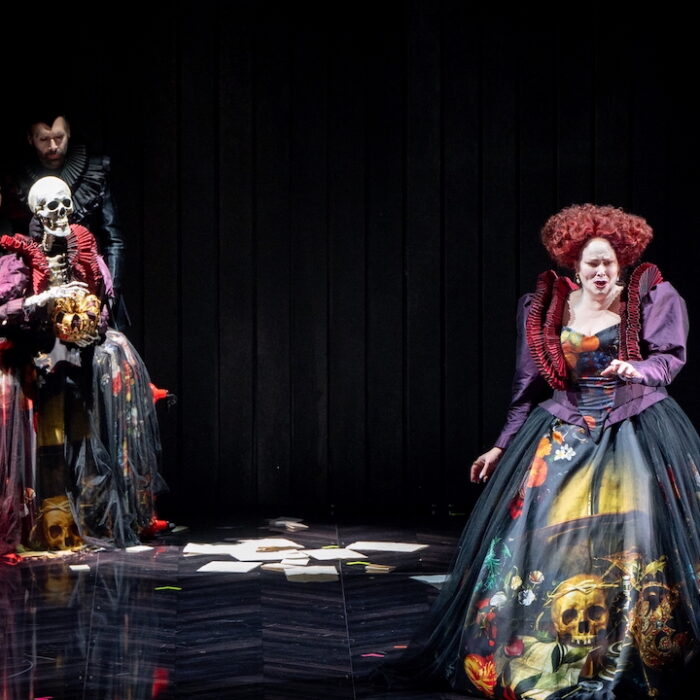
Metropolitan Opera 2018-19 Review: La Clemenza di Tito
Joyce DiDonato, Elza Van Den Heever, & Matthew Polenzani Lead Incredible Cast In Mozart Masterwork
By David Salazar(Credit: Richard Termine / Met Opera)
Mozart’s “La Clemenza di Tito” is undeniably one of his greatest operas.
The work certainly has its dramatic challenges, but it is hard to look at the score and find one piece that misses the mark. Every single musical number is vibrant, full of life, and unique in its own way. Not even the greatest and most famous of Mozart’s operas, “Le Nozze di Figaro” can survive a performance without a few of its weaker numbers being cut. But “Clemenza” is musical perfection from start to finish. And if that weren’t enough, the opera really shines in its recitatives, where the composer placed a great deal of the emotional conflicts for its major characters.
It is a musical masterpiece like few before or after it.
Its virtues were on full display at the Metropolitan Opera on Wednesday, April 3, in the second performance of the current run.
The production by Jean-Pierre Ponnelle is a creative sister to that of “Idomeneo,” but might actually be stronger in many respects. Despite its imposing set with its Roman architecture, this is minimalism at its finest. The sets rarely change and the staging simply takes up and uses the space in an efficient and clear manner. There are no pretensions of adding to a story that ultimately shines the spotlight on a series of indecisive and scared individuals. The lighting is effective, particularly in evoking the flames of Rome at the end of the first Act or in spotlighting Vitellia at her lowest moment. And what’s more, the scene transitions are quick, direct, and to the point. Combined with the revival direction by Peter McClintock, it might just be the most elegantly executed production at the Met all season.
This is only aided by having a cast that is of the highest order.
Heart & Soul
While the opera’s title places the focus on the final action of the ruler Tito, Sesto is the true heart and soul of this opera. Sesto is the motor of the plot, his actions, and indecisions pushing other characters toward crisis. This can also make him the most frustrating of characters, but there is no denying that a strong Sesto can really take this opera to the next level.
That’s exactly what Joyce DiDonato did in what might be her finest hours at the Met to date. All the other characters onstage loomed over her, which added to the sense of frailty and vulnerability that one immediately perceived about her Sesto. There was complete engagement from the beginning as DiDonato charted the character’s downward trajectory. While Sesto might be saved and forgiven at the close of the opera, there is always this overbearing feeling that something has irreversibly broken in this character. In DiDonato’s hands, it all felt like a big tragedy for this character.
Vocally, you could feel every moment and transition in the character’s fraying emotional state. Take “Parto, parto,” one of the opera’s most iconic passages, often a vehicle for young mezzos to use in auditions and masterclasses. It has but eight lines of text, but lasts close to seven minutes and really comes down to Sesto begging Vitellia to make peace with him before he leaves to kill Tito. The text gets repeated over and over throughout the aria and in the hands of lesser artists, the aria’s rhapsodic structure can lose its way in the middle of the aria. But DiDonato did something extraordinary.
The opening of the aria was sung in hushed tones, begging Vitellia meekly to forgive him. But with her continued indifference, the voice grew in sound and intensity, the plea becoming more and more desperate; the vibrato grew wider and more present as a result. In the middle of the aria, Mozart left two “guardami” between extended fermata rests. The first of these played off what had come before and DiDonato gave it an imposing forte delivery. But finding her Sesto rebuffed, she moved ever close to Vitellia and with the softest sound imaginable, practically wept the ensuing “Guardami.” It’s one of those moments that reminds you how powerful and emotionally wrenching Mozart’s music could be in the right hands. Finding Vitellia unmoved, DiDonato turned up the aggression for the Allegro Assai section of the aria, complete with pitch-perfect coloratura runs that seemed to embolden her resolve.
Of course, by the next scene, her Sesto was back to his indecisive self, and DiDonato’s voice thundered as Sesto grappled with his pain.
Sesto’s second aria, “Deh, per questo istante solo” was equally rich in its emotional range. Again, DiDonato’s first notes were gentle and soft, every sound almost a weep. This was Sesto and his most vulnerable and beaten and you could sense DiDonato’s Sesto doing all he could to connect with Tito one last time. As in “Parto, parto,” DiDonato’s Sesto spent all his time singing to someone’s back, but the constant search and yearning for connection made these moments among the most painful to endure.
Sad But Virtuous
In the title role, Matthew Polenzani seemed to get off to a rugged start in his portrayal of the eternally suffering Roman emperor. Some of the pitches were off in the first two arias “Del più sublime soglio” and “Ah se fosse,” the latter one’s opening phrases sounding particularly off and his voice simply sounding a bit dry and lacking in brightness. But Polenzani is a masterful singer and even with these challenges early on, he managed to infuse every line with intensity and untouchable legato. There are few singers capable of drawing such an elegant line in a Mozart opera that feels refined and yet full of excitement all at once. This was more evident during recapitulations of these arias, Polenzani opting to sing them pianissimo to extraordinary effect. Even if you came to expect that approach on all the solo numbers, the impact of his voice projecting so much rich emotion with such little sound was always felt.
But the second half of the evening was undeniably the best for the tenor, his voice full of brightness on “Ah no, sventurato non sono cotanto,” the ends of the lines diminendoed elegantly.
But Tito’s best material comes in the ensuing scenes and Polenzani rose to the challenge as only he could. As he vacillated between condemning Sesto or saving him, his voice shifted from a forte quality to a soft fil di voce, perfectly encapsulating the conflicts of his soul. The extended recitative “È pur di chi regna” was one of the most arresting moments of the evening, Polenzani singing his softest yet able to immerse the listener in the emotions and imagery he relates.
Then came the incredible scene with Sesto, full of tension and conflict. After using the full resources of his voice and even blasting out his sound on “Non odi?” his sudden shift to pianissimo singing on the recitativo “Odimi, oh Sesto; siam soli,” felt like the taking off of a mask, furthering the sense of Tito navigating two spheres carefully. He delivered the entirety of this passage with hushed tones, giving him increased vulnerability and adding to the suspense of the moment.
When faced with Sesto’s rejection, he turned back up his volume, blasting out his sound in authoritative manner and ignoring his friend’s pleas to look to him. We could see his continued inner turmoil, which ratcheted up the tension for the ensuing scene when he finally condemned his friend to death. And yet, right away, he stopped himself, setting up the famed “Se all’impero” which Polenzani delivered with great vocal vibrancy and strong technical proficiency. The coloratura was not spotless, but few tenors have managed it as well with full voice and pianissimo singing.
The final scene was the lynchpin of it all with the tenor finally looking somewhat pleased after an entire evening of his Tito looking conflicted, upset, and downright unhappy. It was a strong performance from one of the great tenors in the world.
From Powerful To Powerless
As Vitellia, Elza Van Den Heever continued to showcase her incredible ability to inhabit a role. Her Vitellia was a dominant figure from the beginning, toying with Sesto and pushing him to do her bidding. She tortured him with her indifference throughout the opening scene and especially during his “Parto, parto.” Even as DiDonato gave everything to her in these moments, Van den Heever’s Vitellia was as firm as a rock, not giving Sesto a single look. The funniest moment of the night was her entrance after it is revealed that Servilia is to be empress. Appearing in a huge black dress all the way upstage, she slowly moved down, every step accompanied by harpsichordist Bryan Wagorn to perfection.
But then she crumbled, starting with the trio “Vengo … aspettate … Sesto!…,” where she finally seemed aware of her mistakes. Van Den Heever’s high B’s in this passage seemed like increasing cries of desperation and her entire body looked unstable and ready to fall over. After this, Vitellia would become increasingly conflicted as a character, looking more vulnerable and eventually defeated in her famed aria “Non più di fiori.”
The two arias that frame Vitellia’s journey through this opera are truly the test for any soprano taking on the opera and Van Den Heever rose above and beyond. The first aria emphasizes tremendous virtuosity and flexibility with coloratura runs, gentle and seductive phrases, and a lot of imposing low notes. Van Den Heever managed the transitions of this aria with tremendous vocal strength and muscle, exerting her sense of control. Her repeated “alletta” increasingly taunted Sesto with their sensuality utterances. She was almost a snake throughout and it made her both alluring and frightening at once.
Meanwhile, her final aria “Non più di fiore” was on the far end of the spectrum and really placed a focus on her ability to weave sustained legato lines. Her forays into the low end of her soprano expressed a sense of pain and suffering that seemed to grow throughout the course of the extended solo. She made you feel for this now-broken woman in a way that was impossible to imagine.
A Rising Star
Emily D’Angelo is quickly becoming a major name in the opera world and her performance as Annio certainly revealed why. From the get-go, she was fully committed to every moment she was onstage, even if she wasn’t singing. This was most present in the opera’s opening scene where she looked exceedingly uncomfortable watching Vitellia toy with Sesto. When she came toward Annio, D’Angelo did his best to turn away from Vitellia’s advances. D’Angelo’s Annio was undeniably the bright light of the evening, always looking poised and energized for every moment of conflict. There was rarely a moment of quiet in this interpretation, often making Annio feel like the only decisive hero in this story.
Vocally the mezzo backed up this portrayal with rich vocal prowess defined by a sturdy middle and flexibility up top. It isn’t the most resonant voice and there were times when Joyce DiDonato’s mezzo covered D’Angelo’s during the duettino “Deh, prendi un dolce amplesso,” but D’Angelo more than made up for that with a vibrant reading overall. This was particularly evident in the famed aria “Torni di Tito al lato” and “Tu fosti tradito,” both exhibiting warm and bright energy. She navigated the transitions between her middle and top with purity of line.
But perhaps her most potent moment of the night was not even an aria, but how she managed a specific passage of recitativo, “Augusto, conosco di Sesto il cor.” In this passage, Annio urges Tito to take the hand of Servilia, even if it means losing the love of his life. Even before the passage, you could see the torment in D’Angelo’s body language, but her Annio seized control of the situation and despite a clear internal battle, made a noble sacrifice. D’Angelo displayed all of her incredible vocal qualities in this particular passage, singing with purity of vibrato-less sound on “Virtù, bellezza, tutto è Servilia” and really making us feel the intense love and sense of loss all at once.
Strength & Order
As Servilia, Ying Fang delivered lush and gorgeous sound. She was the suitable contrast to the cruder vocal qualities of Van den Heever, making her feel like the purer of the two female characters. She meshed beautifully with D’Angelo’s voice in their duet “Ah, perdona al primo affetto,” adding to her perceived angelic qualities. She could have played up that sense in the aria “S’altro che lacrime,” as many sopranos tend to do. But Fang used the aria to give Servilia greater strength. She circled around the fallen Vitellia, pointedly looking down at her as she said “tutto il tuo piangere non gioverà.” She wasn’t begging her to act, but instead guilting her. In this way, Servilia seized control of the moment, suddenly making Vitellia vulnerable and adding to the complexity of both of their characters. But toward the end of the aria, you could feel she was also shattered by the situation and resorting to begging with the sublime, floated, and crescendoing high As on “gioverà.” This shift in emotional direction only added to the tension of the scene and unpacked the rich dramatic qualities of an aria often performed on one emotional track.
As Publio, Christian Van Horn displayed a regal and potent figure that towered over all others. Even if he was not an antagonizing figure, his simple presence, coupled with a potent and dark bass-baritone created a sense of intimidation represented by the rule of law. He looked immovable onstage. Just a simple stare towards Polenzani’s Tito immediately hinted at the tensions of the ruler between his duty and his personal desires. Van Horn’s rendition of “Tarde s’avvede,” while not forceful, was far from fatherly or gentle. There was rigidity in the aria that cohered with his being a figure of constant law in the opera.
In the pit, maestro Lothar Koenigs put on a solid musical display. He tended toward more relaxed tempi from the overture onward, many clearly intended on helping the singers get through some of the most difficult passages. But there was always a sense of space in the drama, giving it greater weight as well.
The second half of the Metropolitan Opera’s 2018-19 season has been far superior to its first portion and this set of performances of “La Clemenza di Tito” are representative of that. This is a top-rate cast in a potent production that likely would have deserved an HD broadcast. But because that is not the case, it is even more important to check it out while it is still playing.


